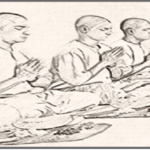Nasadiya Sukta
Humans have long wondered about the mysteries of the cosmos. Nasadiya Sukta (Rigveda 10.129) has answered such questions and clarified that the reality is unknowable. In Sanskrit, it’s also known as The Achintyam: The Inconceivable.
Using the Hubble Telescope, scientists have estimated that there are 2 trillion galaxies in the observable universe. This implies that there may be more galaxies in the non-observable universe whose light we cannot access. Consequently, our understanding of the cosmos will remain forever limited, leaving us only a limited understanding of the universe.
We live in the Milky Way Galaxy, also known as ‘Akash Ganga’ in Hindi. The stars we see at night are a micro part of it.
According to Phys.org Doing the math, we can then say that the Milky Way galaxy has—on average—between 800 billion and 3.2 trillion planets, with some estimates placing that number as high as 8 trillion!
Using a similar calculation, we can estimate the number of stars in the observable universe. There are around 100 billion stars in the Milky Way. Therefore, using the Milky Way as our model, we can multiply the number of stars in a typical galaxy (100 billion) by the number of galaxies in the universe (2 trillion). The answer is an astounding number: There are approximately 200 billion trillion stars in the universe.
The chances of intelligent life in the universe are amazingly vast. Our lives are the same, but occasionally, they can abruptly change. Hence, the Nasadiya Sukta helps us explore infinity and remain open to new ideas and worlds. When we rigidly adhere to our beliefs and close our minds, we hinder our progress towards self-improvement.
The Achintyam, aka Sri Hari in Hinduism, ponders the idea of The Inconceivable. The idea is that no matter what we think or experience, the absolute, aka The Achintyam, is unknowable. If we wonder about the unknowable aspect of reality, we will make more discoveries. If we want to succeed in business, we will have a different mindset when looking at things that may change history.
Below is the Nasadiya Sukta, which should be read every now and then.
नासदासीन्नो सदासीत्तदानीं नासीद्रजो नो व्योमा परो यत्।
किमावरीव: कुह कस्य शर्मन्नम्भ: किमासीद्रहनं गभीरम् ॥ १॥
nasad asīn no sad asīt tadanīm nasīd rajo no vyoma paro yat |
kim āvarīvaḥ kuha kasya śarmann ambhaḥ kim āsīd gahanam gabhīram || 1 | |
Then even nothingness was not, nor existence,
There was no air then, nor the heavens beyond it.
What covered it? Where was it? In whose keeping
Was there then cosmic water, in depths unfathomed?
———————————————————————————————-
न मृत्युरासीदमृतं न तर्हि न रात्र्या अह्न आसीत्प्रकेतः ।
आनीदवातं स्वधया तदेकं तस्माद्धान्यन्न परः किञ्चनास ॥२॥
na mrtyur āsīd amrtam na tarhi na rātryā ahna āsīt praketaḥ
ānīd avātam svadhayā tad ekam tasmād dhānyan na paraḥ kim canāsa || 2 | |
Then there was neither death nor immortality
Nor was there then the torch of night and day.
The One breathed windlessly and self-sustaining.
There was that One then, and there was no other.
——————————————————————————————
तम आसीत्तमसा गूहळमग्रे प्रकेतं सलिलं सर्वाडइदम्।
तुच्छ्येनाभ्वपिहितं यदासीत्तपसस्तन्महिनाजायतैकम् ॥३॥
tama āsīt tamasā gūļham agre ‘praketam salilam sarvam ā idam |
tucchyenabhv apihitam yad asīt tapasas tan mahinajayataikam | | 3 | |
At first there was only darkness wrapped in darkness.
All this was only unillumined water.
That One which came to be, enclosed in nothing,
arose at last, born of the power of heat.
——————————————————————————————–
कामस्तदग्रे समवर्तताधि मनसो रेतः प्रथमं यदासीत्।
सतो बन्धुमसति निरविन्दन्हृदि प्रतीष्या कवयो मनीषा ॥४॥
kamas tad agre sam avartatadhi manaso retah prathamam yad asīt |
sato bandhum asati nir avindan hrdi pratīşyā kavayo manīsā | | 4 |I
In the beginning desire descended on it.
That was the primal seed, born of the mind.
The sages who have searched their hearts with wisdom
know that which is kin to that which is not.
——————————————————————————————-
तिरश्चीनो विततो रश्मिरेषामधः स्विदासीदुपरि स्विदासीत्।
रेतोधा आसन्महिमान आसन्त्स्वधा अवस्तात्प्रयतिः परस्तात् ॥५।
tiraścino vitato raśmir esam adhah svid asīd upari svid āsīt
retodhā āsan mahimāna āsan svadhā avastāt prayatih parastāt | | 5 | |
And they have stretched their cord across the void,
and know what was above, and what below.
Seminal powers made fertile mighty forces.
Below was strength, and over it was impulse.
—————————————————————————————
को अद्धा वेद क इह प्र वोचत्कुत आजाता कुत इयं विसृष्टिः ।
अर्वाग्देवा अस्य विसर्जनेनाथा को वेद यत आबभूव ॥६॥
ko addhā veda ka iha pra vocat kuta ājātā kuta iyam visrstih |
arvāg deva asya visarjanenatha ko veda yata abab | | 6 |I
But, after all, who knows, and who can say
Whence it all came, and how creation happened?
The gods themselves are later than creation,
so who knows truly whence it has arisen?
————————————————————————————
इयं विसृष्टिर्यत आबभूव यदि वा दधे यदि वा न।
यो अस्याध्यक्षः परमे व्योमन्त्सो अङ्ग वेद यदि वा न वेद ॥७॥
iyam visrstir yata ababhuva yadi va dadhe yadi va na |
yo asyādhyakșaḥ parame vyoman so anga veda yadi vā na veda | | 7 | I
Whence all creation had its origin,
he, whether he fashioned it or whether he did not,
he, who surveys it all from highest heaven,
he knows – or maybe even he does not know.




